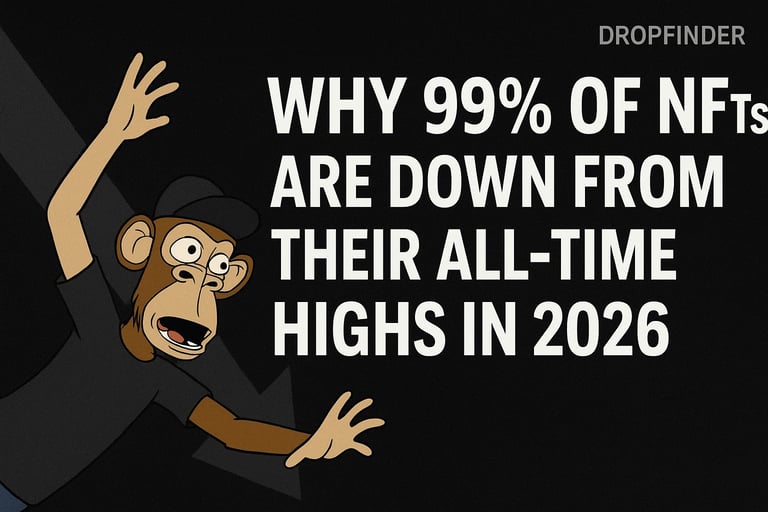Why 99% of NFTs Are Down from Their All-Time Highs in 2026 – The Harsh Reality and Future of Digital Collectibles
Discover why nearly all NFTs have plummeted 99% from their all-time highs by 2026. Learn the key reasons behind the crash, investor psychology, and what the future holds for the NFT market — powered by DropFinder.
CRYPTO NEWSLATEST AIRDROP
10/14/20254 min read
Why 99% of NFTs Are Down from Their All-Time Highs in 2026 – The Harsh Reality and Future of Digital Collectibles
The NFT (Non-Fungible Token) revolution once promised to reshape the digital world. It gave artists, gamers, and creators a new way to monetize digital ownership. From 2020 to 2022, NFTs became the talk of the internet—millions of dollars were spent on digital art, profile pictures (PFPs), and collectibles.
Fast forward to 2026, and the NFT landscape looks entirely different. Over 99% of all NFTs are now down by more than 90% from their all-time highs. What was once a gold rush is now seen as one of the most speculative bubbles of the decade.
In this blog by DropFinder, we’ll explore how the NFT boom turned into a collapse, what led to the downfall, and whether NFTs still hold a future beyond the hype.
1. The Meteoric Rise of NFTs (2020–2022)
In 2020, blockchain adoption was accelerating, and the idea of “digital ownership” became mainstream. Ethereum-based platforms like OpenSea, Rarible, and Foundation enabled users to mint and trade NFTs representing art, music, and even virtual land.
Collections like CryptoPunks, Bored Ape Yacht Club (BAYC), and Azuki became cultural phenomena. Celebrities jumped in—Justin Bieber, Snoop Dogg, and Eminem all owned NFTs worth millions. At its peak, BAYC’s floor price surpassed $400,000, and the NFT market reached $25 billion in sales by 2021.
The dream was alive: digital assets were now as valuable as physical ones.
2. The Overinflated Bubble
The rise was too fast to sustain. By late 2022, NFT valuations were driven more by speculation than utility. Many buyers didn’t care what they were purchasing — only that someone else might pay more later.
Key problems began to appear:
Artificial scarcity with endless “limited editions.”
Copycat projects with no originality or long-term plan.
Wash trading — fake volume to inflate prices.
Celebrity hype without real community value.
As the crypto market crashed in 2022, NFTs followed. Investors realized that paying thousands for a JPEG didn’t guarantee future profits.
3. The Great NFT Crash (2023–2024)
The first major NFT winter hit in 2023.
Ethereum gas fees fell, but so did NFT trading volume.
Projects like BAYC, once worth $400K, fell below $50K.
Blue-chip NFTs lost 80–95% of their value.
Small collections became worthless.
Many NFT founders vanished. Discord servers became inactive. The illusion of “community-driven ownership” faded as liquidity disappeared.
By 2024, 99% of NFTs had dropped over 95% from their all-time highs. Trading volume on OpenSea collapsed from billions to a few million per month.
4. Why 99% of NFTs Lost Value
Let’s dive into the key reasons behind the massive decline.
A. Oversupply
In 2021–22, anyone could launch an NFT project. Millions of tokens flooded the market, but demand didn’t scale. Scarcity lost meaning when there were more than 20 million NFTs on Ethereum alone.
B. Lack of Real Utility
Few NFTs provided actual use cases. Promises of “exclusive access,” “metaverse integration,” or “gameplay rewards” rarely materialized.
C. Speculative Mania
Most buyers treated NFTs as a get-rich-quick scheme, not as digital art. When prices dropped, they exited quickly — collapsing liquidity.
D. Declining Trust
Scams and rug pulls damaged public confidence. From fake collections to stolen artwork, the NFT space became a Wild West of fraud.
E. Crypto Market Downturn
As Bitcoin and Ethereum prices fell, liquidity drained from all risk assets — NFTs being the most volatile.
F. No Tangible Backing
Unlike Bitcoin (scarce, decentralized money), NFTs had no intrinsic value unless tied to something useful, like game items or licenses.
5. The Role of the Metaverse Collapse
The Metaverse narrative was supposed to be the savior of NFTs.
Projects like Decentraland and The Sandbox promised digital economies where land, avatars, and items were tokenized as NFTs.
But by 2024, daily active users in these worlds were less than 5,000, and virtual real estate prices plummeted 95%.
Without a thriving virtual ecosystem, NFT-based assets had nowhere to live — or trade meaningfully.
6. Regulatory Pressure
NFTs also faced regulatory scrutiny in 2025.
Governments began investigating NFTs for:
Money laundering and tax evasion.
Unregistered securities sales.
Intellectual property theft.
When major marketplaces had to comply with stricter KYC and reporting rules, the “anonymous” NFT culture faded. This pushed even more traders out.
7. Psychological Impact and Investor Fatigue
In every financial bubble, there’s a point where enthusiasm turns to exhaustion. By 2025:
Investors grew tired of promises that never delivered.
Artists left NFT platforms as their art stopped selling.
The term “NFT” became synonymous with failure and greed.
The NFT crash mirrored the Dot-com bust — innovation ahead of practicality.
8. Survivors: The 1% of NFTs That Still Matter
Not all NFTs died. Some adapted and evolved.
A. Gaming NFTs
Projects that integrated NFTs into real games with player economies (like Illuvium and Star Atlas) still had activity. Players valued items with functional use.
B. Music & Ticketing NFTs
NFTs in the music industry allowed artists to sell ownership shares, concert passes, or limited tracks directly to fans. Platforms like Audius and Sound.xyz thrived.
C. Luxury Brand NFTs
Brands like Gucci and Nike used NFTs as digital twins — proof of authenticity for physical goods. This utility-driven model survived the hype collapse.
9. Can NFTs Recover in 2026 and Beyond?
The NFT market is evolving again.
New trends emerging in 2026 include:
AI-generated NFTs (interactive digital art).
On-chain gaming assets connected to Layer-2 ecosystems.
Real-world asset NFTs — linking blockchain to real estate, identity, and documents.
NFT rentals — where ownership is temporary and functional.
If NFTs tie themselves to real-world value or strong communities, they could stage a partial recovery.
But the era of million-dollar monkey pictures is gone.
10. Lessons Learned from the NFT Crash
Hype ≠ Value – Popularity doesn’t guarantee sustainability.
Utility is Everything – NFTs must provide clear, ongoing benefits.
Transparency Builds Trust – Projects need open teams, not pseudonymous promises.
Liquidity Matters – Without active markets, digital assets are worthless.
Art and Tech Can Coexist – True digital art still thrives when quality and creativity lead.
11. Long-Term Outlook: The Future of NFTs
By late 2026, the NFT market is slowly restructuring:
Blue-chip NFTs have found stable floor prices, backed by real-world collaborations.
Artists are using NFTs for copyright protection rather than speculation.
New regulations are cleaning up the space.
NFTs may not return to their 2021 glory, but they could become a trusted part of digital identity and ownership.
12. DropFinder’s Perspective
At DropFinder, we’ve tracked countless NFT projects from launch to decline.
Our data shows that innovation alone isn’t enough — execution, transparency, and value delivery determine longevity.
DropFinder continues to highlight genuine blockchain projects with long-term potential, separating the real builders from hype-driven flops.
If the NFT industry learns from its mistakes and focuses on utility and transparency, the future may still shine — just not as brightly as before.
Final Thoughts
NFTs changed how the world perceived ownership, art, and creativity. But the fall of 99% of NFTs serves as a crucial reminder: every innovation faces a cycle of mania, correction, and maturity.
The next wave of NFTs — driven by AI, real-world assets, and gaming — could redefine what digital value truly means. Until then, the market remains a cautionary tale of greed, speculation, and unrealized potential.




